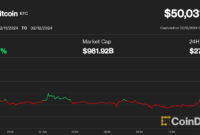Seasoned crypto investors have come to expect volatility. It’s the price of admission for participating in this emerging industry. That being said, it never feels good to lose money, and many popular cryptocurrencies have taken a beating recently. In fact, the crypto market as a whole has fallen 30% from its high in November 2021.
This is hardly the first time the market has crashed, and I doubt it will be the last. But every past downturn has been a buying opportunity. Ethereum remains the second most valuable cryptocurrency, but it currently trades 30% below its all-time high. Is now a good time to buy?
Why Did The Crypto Market Crash?
Two major events in the cryptocurrency space have rocked Bitcoin’s value down to a three-month low as the entire market witnessed a cascading crash. At the time of writing, Bitcoin is valued at $43,168 (roughly Rs. 32.1 lakh), down by over 7 percent over the past 24 hours on global exchanges. On Indian exchanges like CoinSwitch Kuber, the price of the most popular cryptocurrency stands at Rs. 34.92 lakh, down by 6.17 percent over the past 24 hours.
The big slump occurred as the US Federal Reserve indicated it could move up its timetable for raising interest rates to mid-March. The US Federal Reserve is essentially going to stop printing money and make it more expensive to borrow in order to steady the economy and keep rising inflation in check. Meanwhile, Kazakhstan, the country which accounts for a large 18 percent of the Bitcoin network’s hash activity, witnessed a nationwide Internet shutdown, causing BTC’s hashrate to drop by 13.4 percent — reflecting in a sharp fall in value.
Ether, the second-largest cryptocurrency by market capitalisation saw a substantial drop as well. The Ethereum-based cryptocurrency witnessed a plunge of 8.3 percent over the past 24 hours after a healthy start to the year. At the time of publishing, Ether is valued at $3,759 (roughly Rs. 2.79 lakh) on CoinSwitch Kuber while values on global exchanges see the crypto pegged lower at $3,446 (roughly Rs. 2.56 lakh), where the coin saw a steeper drop of 9.73 percent over the past 24 hours. The dip sees Ether’s performance improve marginally but still down 6.8 percent in value over the past week.
Gadgets 360’s cryptocurrency price tracker reveals a bad day for the entire market as stable coin appears to be the only crypto assets to have gained in value. Ripple, Cardano, Polygon, Litecoin, Chainlink, and Polkadot all witnessed drops in value, while Tether, and USDC rose in value.
Meme coins haven’t been spared by the crash either. Dogecoin is down 6.86 percent in 24 hours to be valued at $0.17 (roughly Rs. 12.67). Meanwhile, Shiba Inu is down 7.61 percent to be valued at $0.000032 (roughly Rs. 0.002417). SHIB’s value has dropped by 10.2 percent in the past week, while Dogecoin is down by 6.9 percent.
As per CoinGecko, Bitcoin’s value has dropped by over 7 percent over the past week, even though the cryptocurrency is up by more than 26 percent year-on-date.
What should Bitcoin investors do?
The crypto market is no stranger to volatility. Bitcoin hit a high just below $65,000 per coin in mid-April before plunging over 50% by July due to several factors including news from Tesla and the Chinese government. By October, the price was back to a new high over $66,000.
If you think you can stomach the volatility and want to invest a small amount in Bitcoin, make sure you are going to hold onto it for a longer period of time, and not want to sell when the price drops and you get worried, Anjali Jariwala, certified financial advisor and founder of FIT Advisors, previously told Money.
“You have to be comfortable with having that money potentially go away,” she added.
Crypto will continue to be volatile, Tuttle says. So if you’re planning to buy in, now’s not the time.
“Wait until the trend shows signs of moving up,” Tuttle says.
But if you do decide to buy in, keep in mind that financial advisors recommend only investing a small amount of your portfolio in risky investments like crypto — 5% of your overall portfolio at most.
Don’t look down
Still, investing in digital currency “is not for the faint of heart,” warned Firth, who personally invests in crypto while advising his clients to put no more than 5% of their portfolio in such a volatile asset. Some days an investor will see tremendous gains, but “you still have to prepare for that sudden drop of more than 50% in a matter of a week or so,” he said.
Andrea Hardison, a project manager for a technology consulting firm in Nashville, said she expects huge price swings in crypto in 2022 just like last year. But Hardison, who started buying crypto last April, still plans to continue pouring more money into hex, bitcoin, solana and ethereum, noting that some of her bets have already doubled in value.
Robert White III, a workforce development case worker in St. Louis, is similarly unfazed by the rollercoaster crypto market. White, a bitcoin owner, said he plans to have a portion of his paychecks taken out directly to purchase cryptocurrencies.
“My approach will be consistent and steady,” said White, who bought his first bitcoin in 2017 when it sold for $1,100. “I’m hoping for three times growth of what I’ve invested, but crypto is so volatile that it can go so many different ways within a day.”
A solution for the scalability problem
Unfortunately, that popularity has created a problem. As more users have transacted on the platform, network congestion has caused speeds to slow and fees to rise. Transaction fees have jumped 750% over the last six months. That problem points to a lack of scalability.
For context, Visa regularly processes 1,700 transactions per second (TPS), and its payments platform is theoretically capable of 24,000 TPS. By comparison, Ethereum can manage just 30 TPS. If left unchecked, that low throughput will continue to push fees higher, and eventually, Ethereum will fall out of favor due to its exorbitant fees.
Fortunately, the Ethereum 2.0 upgrade aims to solve that problem. First, it will change the energy-intensive proof-of-work consensus mechanism to the eco-friendly proof of stake (PoS) architecture. The PoS system selects validators to verify transactions based on their stake in the network, rather than pitting miners against each other based on computing power. This phase should take place in 2022.
Second, the upgrade process will add 64 shard chains to Ethereum. Think of these shard chains as additional blockchains connected to the core chain, distributing the network load more efficiently. And with a few additional tweaks, those shard chains could raise throughput to 100,000 TPS, thereby solving the scalability problem. This phase should arrive in 2023.
The investment thesis
While dApps and DeFi products are more efficient, they aren’t free. Users pay transaction fees to access the products, and those fees are paid in the native cryptocurrency. In the context of Ethereum, that means Ether tokens. In other words, as dApp and DeFi products on the Ethereum blockchain become more popular — an event that seems likely, in light of the benefits — demand for Ether should rise, pushing its price higher.
Additionally, a recent study from Nickel Digital Asset Management suggests that institutional investors are increasingly interested in the crypto space. The study predicts that 82% of institutional investors plan to increase exposure to digital assets by 2023. Given Ethereum’s popularity, I think it’s safe to assume those big money movers will add to the demand for Ether.
For these reasons, now looks like a good time to buy this cryptocurrency.



